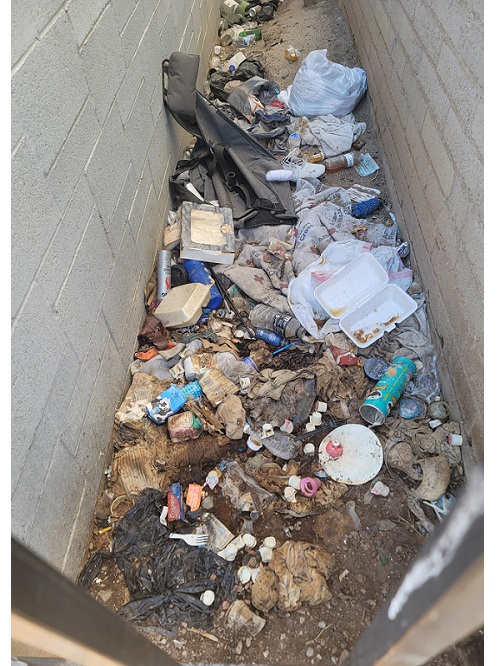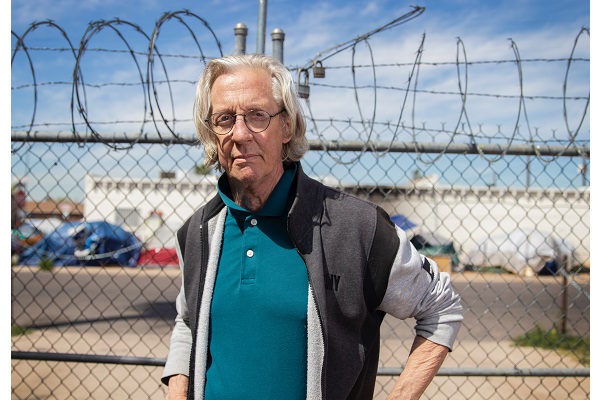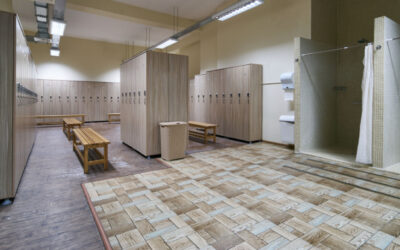By Corinne Murdock |
You’ll know you’re in The Zone by the smell.
The suffocating stench of urine and feces. Rotting garbage. The occasional whiffs of fentanyl, or the synthetic drug Spice clouding the air. Dead bodies. No, it’s not a Third World nation—it’s a lawless encampment of over 1,000 homeless people in downtown Phoenix, where crime is rampant, and the city does virtually nothing about it.
The city’s inaction provoked a lawsuit by business owners in the Zone who are suffering the consequences of the unchecked homelessness crisis. This week, a Maricopa County judge issued a preliminary ruling, finding that the city has “intentionally stopped—or at least materially decreased—enforcement of criminal, health, and other quality of life statutes and ordinances in [T]he Zone,” effectively making it “off-limits to [law] enforcement.” That’s good news for the business owners, but the decision is just a first step in the long process of solving the problem.
Karl Freund — who was leasing a building in The Zone and is suing the city over the homeless crisis — described to AZ Free News a state of apathy toward improvement for both the homeless and those assigned to handle it.
“You see trash everywhere. These people just don’t give a flip anymore, you know?” said Freund. “I see these people smoking meth wide out in the open. I’ll go over to them and tell them to leave. Then they’ll just go to another corner.”
The apathy has turned the once-thriving residential and business district into a depressed wasteland of death and depravity. Freund had plans to run a real estate business in the building he’d leased. Destruction to his property and the undesirability of the area caused by the homeless encampments has made that impossible; per AZ Free News’ initial report, he spent hundreds of thousands to fight for the property before having to find another to sublet it.

Sanitation is a far-off dream in The Zone — not only for the homeless, but also for those residents and business owners stuck there. These biohazardous slums are also affecting the rest of the state. Photographic evidence submitted in court filings reveals that unmanaged sewage and trash end up in storm drains. Drains which discharge into rivers, washes, and retention bases. The Zone is polluting Arizonans’ water on a daily basis, uninhibited.
AZ Free News spoke with a lawyer on the lawsuit against the city alleging a failure to take care of The Zone, Ilan Wurman, about the environmental hazards that The Zone poses (Brown v. Phoenix). Wurman confirmed that the constant deluge of waste ending up in our waterways violates state law.
“Their trash and waste goes into the storm drains and ends up in the waterways. That’s illegal discharge,” said Wurman.
The human waste and garbage that doesn’t end up in waterways creates other problems. Namely, they attract rodents and flies: a breeding ground for disease.
It was rats that resurrected a “medieval” disease in Los Angeles, California’s homeless population over the last decade: the bubonic plague. That accompanied the resurgence of other diseases rarely seen in this modern age, typhus and typhoid fever, alongside the persistent problem of hepatitis A and staph outbreaks. Around 1,000 were infected by hepatitis A from 2017 to 2019 in Southern California — even before the surge in the number of homeless that occurred during the pandemic — leaving just under two dozen dead. Typhus increased by thirteen-fold over the course of a decade in the area, from just over a dozen to just under 200 cases.
AZ Free News was unable to locate data from either Maricopa County or the state on communicable disease outbreaks other than COVID-19 in recent years.
Both court precedent and statute indicate that the city has a legal duty to not allow these hazards. Wurman referred AZ Free News to the justifications made for this argument in their recent motion for summary judgment issued in March.
“[A]ny person who knowingly maintains or commits a public nuisance or who knowingly fails or refuses to perform any legal duty relating to the removal of a public nuisance is guilty of a class 2 misdemeanor.” — A.R.S. Section 13-2917(D)
The city admits per court filings and testimony that conditions in The Zone are a “biohazard” due to the human waste, drug paraphernalia, and trash. Gina Montes, deputy city manager, said The Zone created “sanitation issues”; Scott Hall, deputy director of the Office of Homeless Solutions, admitted that the cleanups require “sanitation chemicals.”
“Their cleanup crews come in with hazmat gear. They expect us to accept those conditions in their neighborhood when they themselves have to wear those suits,” said Wurman.
The results of cleanup efforts only last a day at most, per testimony given by plaintiffs in court and by residents in interviews with AZ Free News. Cleanup crews also require police escorts due to the risk of violence they face, per city testimony. Yet residents and business owners must face The Zone on their own every day.
Up until last January, the city conducted cleanups three times a week: Mondays, Wednesdays, and Fridays. Items that couldn’t be moved were trashed. That was part of what prompted the DOJ to begin investigating the Phoenix Police Department in August 2021, reflecting tensions between a community desperate for better sanitary conditions and an unwavering political belief in protecting property rights for the homeless. Office of Homeless Solutions director Scott Hall claimed to reporters last November that the city wasn’t aware of property being thrown away.
The city resumed cleanups last December. However, the effects of these cleanups were only temporary since crews conducted these cleanups on a block-by-block basis. By the time crews reached the next block, the previous block they’d just cleaned had returned to its original state. City workers also offered services to the homeless while cleanups were underway; only 33 accepted, with the rest electing to return to a life on the streets.

Cities that have dealt with a homeless crisis for far longer have experienced serious environmental dangers from mass encampments. Seattle, Washington has struggled to mitigate its homeless for decades, with reports highlighting 2005 as the first year that city officials first introduced a plan to tackle the problem. Thornton Creek Alliance (TCA), an environmental nonprofit focused on restoring Seattle’s waterways, has spoken out for years about the serious negative consequences of homeless encampments on the environment.
“The impact of homeless camps on nature is a concentrated version of the usual impacts of human settlement on nature: impervious packed soils, concentrations of human body waste, food waste, packaging waste, abandoned equipment and shelter materials, contamination by household and drug chemicals, destruction of existing wildlife and plants, pollution of watercourses and possibly water sources,” explained TCA board member Dass Adams in a statement to AZ Free News. “We have seen these effects here and we take care to discourage encampments in parks and natural areas that exist for healthful benefits for our citizens.”
In other reports, TCA warned that specific public health threats posed by homeless encampments included E. coli fecal coliform bacterial contamination of waterways. Such contaminated waterways usually indicate the presence of other waterborne pathogenic diseases such as typhoid fever, hepatitis A, and dysentery.
AZ Free News spoke with Mike Godbehere, one of the residents suing the city over alleged failure to maintain The Zone. His family’s auto supply company was located within The Zone — it had long predated it but didn’t outlast it.
Godbehere’s grandfather started the family business in 1947, after World War II ended and his service was concluded.
“My grandfather was an auto painter. When he came out of the war, WWII, he began selling services like matching color and pinstriping for body shops. One of the paint companies needed a paint distributor in our town,” said Godbehere. “Our family, four generations, have worked there including cousins and aunts and uncles. It was a business that supported our family through that length of time.”
Four generations interrupted by The Zone. Godbehere still owns the property, but leasing remains an issue. Those who most recently contracted to lease the place left before their lease was up — they opted to pay the remaining 24 months of rent rather than remain.
Godbehere said the smell of the human feces and urine saturating the ground just outside the building overwhelms him. Yet, he shared that the Maricopa County Health Department told him that since his complaint concerned property just inside the sidewalk that it was his responsibility.
Then, there’s the fires. One building on Godbehere’s property is older, with wooden double doors dating back to the business’ beginning. It comes close to going up in flames often, due to the homeless starting fires within several feet of it. Godbehere attempted to communicate with the homeless to dissuade them from starting these fires, then contacted police for assistance, but to no avail. One woman behind most of the recent fires refused city services; under current protocols, the city won’t forcibly remove the homeless from their chosen spots.
“Each day that passes I’m wondering when I’m going to get the phone call that my place will be on fire,” said Godbehere.
Joel Coplin has his art gallery in The Zone. Over the years, he observed that the sanitation issues follow the individuals under housing-first approaches — leading him to oppose it. He said he could only imagine that kind of approach working with supervision. He expressed appreciation for Gov. Katie Hobbs’ proposal to install repurposed shipping containers as supervised housing.
“I’ve taken them to their apartments, and I’m astounded at the rents these people are receiving for this. The tenant has to pay a third or a quarter for it, but the place gets immediately trashed,” said Coplin. “If you look at the tents and how there’s all this garbage, that goes in the apartment. It winds up being a junkyard with a pathway through it from the door to the bathroom and the bed. You have to have supervision otherwise it gets trashed.”

Coplin compared The Zone to one of the seedier boroughs of New York.
“It’s like being in Brownsville, Brooklyn, except there’s no corner store to hang out at, so they all just hang out by their tents,” said Coplin. “I open my door and you can hear them, doing their drugs, playing their music, and having a great time. It’s a beautiful life: free rent, all the drugs you want, all the sex you want — if you have the drugs. The only problem is someone might beat you up for all the drugs.”
About a month ago, Coplin witnessed one of the many deaths that occur in The Zone. A homeless man he’d come to know on a first-name basis, Lamar, was shot and killed. Coplin explained that the homeless have tribe-like groups that fight one another.
Total deaths in The Zone have increased at an exponential rate over the last few years. The Maricopa County Medical Examiner Office reported just over 200 deaths in 2018, a year before the homeless crisis picked up. Last year, there were over 700.
Despite the squalor worsening all around him, Coplin said he’s determined to stick around, hopeful he’ll witness a revival in the area. He and other artists migrated there decades ago because it was affordable: a common backstory for those establishing a historic arts community.
“I want to see it through. I want to see our dream come true and try to put some gas on it. I want these people off the street, in some place better for them so they don’t have to crap on the sidewalk and pour my pee on the plants,” said Coplin.
Corinne Murdock is a reporter for AZ Free News. Follow her latest on Twitter, or email tips to corinne@azfreenews.com.








